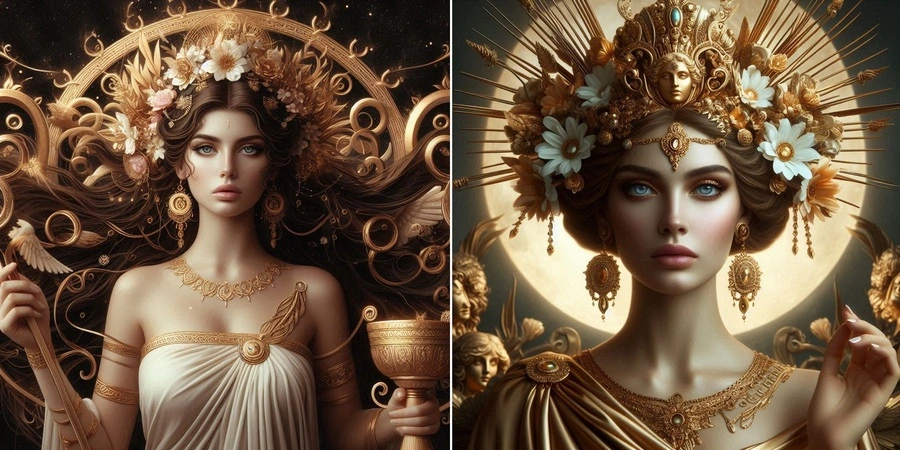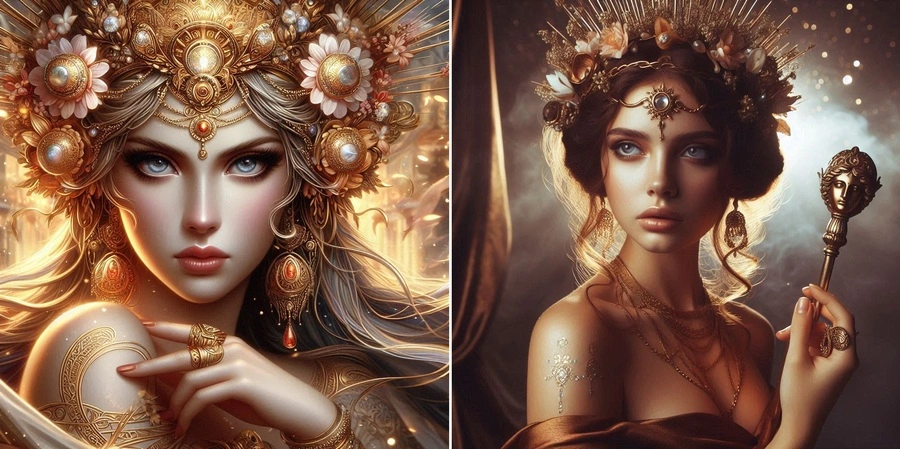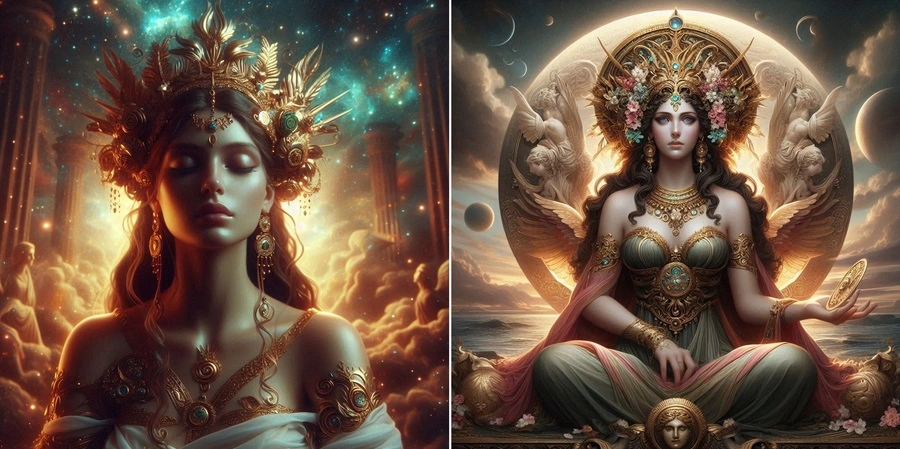
Hera was one of the most powerful deities in Greek mythology, and she was known as the queen of the gods. She was the wife and sister of Zeus, the king of the gods, and was worshipped as the goddess of marriage and childbirth.
Who was Hera?
Hera was the daughter of the Titans Cronus and Rhea, making her one of the Olympian gods. She was born on Mount Olympus, and from a young age, she was known for her beauty and intelligence. Her father Cronus, who was paranoid about being overthrown by his own children, swallowed her whole just after she was born. However, her mother Rhea tricked Cronus by hiding her youngest son, Zeus, and he eventually rescued his siblings, including Hera.
The Story of Hera
Hera’s power stemmed from her dual roles. As the queen of the gods, she shared Mount Olympus with Zeus, wielding authority alongside him. Images depict her as a majestic figure, often crowned and holding a scepter, symbolizing her position and influence. However, her significance extended far beyond the godly court. Hera was fiercely protective of women, especially during childbirth. In some regions, she was even worshipped as Eileithyia, the goddess of childbirth, highlighting her nurturing and life-giving aspects.
Hera’s most celebrated domain was marriage. She presided over wedding ceremonies, ensuring the sanctity and legality of the union. This patronage stemmed from her own complex marriage to Zeus. Their union, though symbolic of the ideal marriage for mortals, was far from idyllic. Zeus, notorious for his infidelity, fathered numerous children with other goddesses and mortals. Hera, the very embodiment of marriage, found herself constantly battling for her husband’s loyalty. This struggle fueled her jealous rage, a character trait heavily emphasized in myths.

Hera’s wrath towards Zeus’s lovers and their offspring is a recurring theme in mythology. She persecuted them relentlessly, showcasing the destructive side of her jealousy. Her targets included the demigod Hercules, the love child of Zeus and Alcmene, who endured numerous trials orchestrated by Hera. However, beneath the fury resided a fierce protectiveness. Hera, despite her clashes with Zeus, remained fiercely loyal to Olympus and its ideals. She actively participated in protecting the Olympian order, even when it meant opposing her husband.
Family of Hera
Hera was the sister and wife of Zeus, and they had three children together: Ares, the god of war; Hebe, the goddess of youth; and Eileithyia, the goddess of childbirth. Despite being married to Zeus, Hera had many other children through various affairs.
Hera also had several siblings who were also Olympian gods and goddesses. Her brothers included the gods Poseidon and Hades, while her sisters included the goddesses Demeter and Hestia.
10 Myths and Facts about Hera
- The Cunning Bride: We all know Zeus wasn’t exactly faithful. However, few know that Hera outsmarted him to secure their marriage. Fearing Zeus would devour her as he did his previous wives, Hera tricked him into drinking a potion that made him vomit her back up, forcing him to officially claim her as his wife. This myth highlights Hera’s resourcefulness and agency in a world dominated by male gods.
- The Protector of Women, Not Just Wives: While Hera is the goddess of marriage, her concern for women extended far beyond the marital realm. She was revered as a protector during childbirth. Some cities even worshipped her as Eileithyia, the goddess of childbirth, blurring the lines between the two deities. This dual role highlights Hera’s multifaceted nature as a guardian of women throughout their lives.
- A Touch of Vengeance, a Hint of Motherhood: Hera’s wrath towards Zeus’s numerous affairs is legendary. However, she wasn’t above playing a more maternal role towards some of his illegitimate children. After Zeus impregnated the nymph Maia, Hera discovered the baby – Hermes, the messenger god – and surprisingly raised him herself. This act showcases the multifaceted nature of Hera’s emotions.
- A Queen with a Competitive Streak: Hera wasn’t content to just share the throne with Zeus. She actively competed with him for influence and power. Myths depict her manipulating events, forging alliances with other gods, and even attempting to overthrow Zeus on several occasions Hera was a formidable queen who refused to be relegated to a mere figurehead.
- The Apple of Discord and the Trojan War: Eris, the goddess of discord, famously tossed a golden apple inscribed “To the fairest” amongst the goddesses. Hera, Aphrodite, and Athena all vied for the title. The resulting dispute led Paris, a Trojan prince, to award the apple to Aphrodite in exchange for the love of Helen, the most beautiful woman in the world. This event sparked the infamous Trojan War, highlighting Hera’s role in shaping human destiny.
- More Than Just a Jealous Wife: Modern interpretations often portray Hera solely as a jealous wife consumed by Zeus’s infidelities. However, her motivations were far more complex. Hera valued order, loyalty, and the sanctity of marriage – ideals constantly trampled by Zeus. Her anger stemmed not just from jealousy, but from a deep-seated desire to uphold the very foundations of Olympian society.
- A Cow with Cosmic Significance: Hera’s association with the cow goes beyond mere symbolism. According to one myth, Zeus, disguised as a bull, abducted a beautiful Io, one of his many affairs. Hera, upon discovering the deception, transformed Io into a white cow and tormented her relentlessly. The white cow became a symbol of both Hera’s wrath and Io’s tragic transformation.
- Beyond Mount Olympus: Hera’s worship wasn’t confined to Greece. She was revered throughout the ancient Mediterranean under various names, including Juno in Roman mythology. These diverse cultural interpretations highlight the enduring appeal of Hera’s complex character and the universality of the themes she embodies.
- A Muse for Millennia: Hera’s story has inspired artists, writers, and philosophers for centuries. From ancient sculptures depicting her majestic regality to modern feminist interpretations that explore her strength and resilience, Hera continues to spark creative expression. Her complex character offers endless possibilities for reinterpretation.
- A Legacy of Duality: Hera’s legacy is one of duality. She is both the protector of marriage and a victim of infidelity, the embodiment of feminine power and a symbol of vengeance. This complexity is what makes her such a captivating figure. Hera reminds us that even the divine experience the full spectrum of human emotions – love, hate, loyalty, and betrayal.

The Symbols of Hera
Hera, the esteemed goddess of marriage and queen of the gods in Greek mythology, is richly adorned with symbols that reflect her authority, character, and divine attributes. These symbols not only define her iconography but also offer insights into her complex role within the pantheon of ancient Greek deities.
The Peacock: Symbol of Majesty and Watchfulness
One of the most prominent symbols associated with Hera is the peacock. Known for its resplendent plumage and distinctive appearance, the peacock symbolizes Hera’s regal presence and majestic stature among the gods. In mythological narratives, the peacock’s watchful eye feathers were believed to symbolize Hera’s ability to see and oversee all, emphasizing her role as a vigilant guardian of marital sanctity and family life. The peacock’s association with Hera underscores her authority and the divine splendor she embodies as the queen of the gods.
The Cow: Symbol of Nurturing and Fertility
Another significant symbol linked to Hera is the cow. In ancient Greece, the cow was revered as a symbol of nurturing and fertility, attributes that align closely with Hera’s role as a protector of mothers and children. The cow symbolizes Hera’s nurturing aspect, emphasizing her domain over the fertility of the earth and the well-being of families. As the goddess who presided over marriage and childbirth, Hera’s association with the cow underscores her role in ensuring the continuity and prosperity of human life.
The Diadem and Scepter: Symbols of Sovereignty and Power
In depictions of Hera, she is often portrayed wearing a diadem and holding a scepter, symbols that signify her sovereignty and authority as queen of the gods. The diadem, a crown worn as a symbol of royalty and divine lineage, underscores Hera’s status as the foremost goddess in the Olympian pantheon. Paired with the scepter, which represents her power and governance over both mortal and divine realms, these symbols highlight Hera’s role as a formidable and influential deity whose decisions and actions shape the course of mythological narratives.
Pomegranate: Symbol of Fertility and Marriage
The pomegranate holds symbolic significance in Hera’s mythology, representing fertility, abundance, and the sacred union of marriage. In ancient Greek rituals and iconography, the pomegranate was often associated with Hera’s blessings upon marital unions and the prosperity of families. Its seeds, bursting with life and potential, symbolize the fruitful outcomes of Hera’s protection and patronage over the institution of marriage. The pomegranate thus serves as a potent symbol of Hera’s role in fostering harmony and fertility within the sacred bonds of matrimony.
Lilies: Symbols of Purity and Renewal
Lilies are also linked to Hera, symbolizing purity, renewal, and the divine grace associated with the goddess. In mythological tales, lilies were often depicted as blooming in Hera’s presence, signifying her benevolent influence over the natural world and her ability to bring about new beginnings and transformations. The lily’s delicate beauty and fragrance evoke Hera’s nurturing and protective qualities, highlighting her role in guiding and safeguarding the cycles of life and growth.
| Throughout history, Hera’s symbols have been prominently featured in ancient art, architecture, and religious ceremonies. Temples dedicated to Hera, such as the Heraion of Samos and the Heraion of Argos, were adorned with sculptures and images depicting her symbols, reinforcing her role as a revered deity of marriage, family, and divine order. |

Frequently Asked Questions
What does Hera look like?
Hera’s appearance is often depicted as majestic and mature, radiating both beauty and authority. Here are some key features:
- Age: While a goddess and technically ageless, Hera is usually portrayed as youthful and in her prime.
- Attire: She is adorned in flowing robes, befitting her status as queen.
- Crown: A distinctive feature is her crown. It can be a cylindrical crown called a polos or a diadem, a jeweled headband.
- Veil: Sometimes, she is depicted with a veil flowing down the back of her head, symbolizing her status as a married woman.
- Scepter: Often, she carries a regal scepter, a staff embellished with jewels or carvings, signifying her power and authority.
Why did Hera hate Hercules?
Hera’s intense dislike for Hercules stemmed from a mix of factors:
- Zeus’s Infidelity: Hercules was the son of Zeus and Alcmene, born from one of Zeus’s numerous affairs. Hera viewed Hercules as a constant reminder of Zeus’s infidelity and a potential threat to her position and lineage.
- A Power Struggle: Hercules, a demigod, displayed immense strength and hero potential. Hera, concerned about maintaining the established order on Olympus, may have viewed him as a challenge to the existing power structure.
- Jealousy of a Mortal’s Son: Hercules’ exceptional abilities, bestowed upon him by Zeus, could have fueled Hera’s jealousy. She might have resented the attention and favor Zeus showered upon this offspring born from an illicit affair.
These reasons combined fueled Hera’s relentless pursuit to make Hercules’ life difficult. She orchestrated numerous trials and obstacles throughout his life, hoping to see him fail. However, Hercules’ perseverance and his eventual status as a god himself showcased his strength and ultimately brought a measure of resolution to their conflict.
What powers does Hera have?
Hera, the goddess of marriage and queen of the gods in Greek mythology, possesses a range of powers and attributes that reflect her divine authority and influence within the Olympian pantheon:
- >Authority and Command: As the queen, Hera held immense authority over the gods and goddesses. She is often depicted with a scepter, symbolizing her power to command and influence events.
- Marriage and Family: Hera presided over weddings and blessed marital unions. She also possessed the power to protect women during childbirth and ensure the well-being of families. In some cities, she was even worshipped as Eileithyia, the goddess of childbirth.
- Magic and Manipulation: Myths depict Hera wielding magic to influence events, manipulate situations, and even briefly usurp Zeus’s power.
- Transformation: Some myths suggest Hera possessed the ability to transform others, showcased in the story of Io, Zeus’s lover, who was turned into a white cow.
- Vengeance and Wrath: Hera’s most well-known ability is her fierce jealousy and vengeful nature. She relentlessly pursued those who wronged her, particularly Zeus’s lovers and their offspring.
- Animal Associations: Hera had strong connections to specific animals. The majestic peacock symbolized her regality, the cow represented fertility and nurturing, and the cuckoo held complex meanings related to renewal and deception.